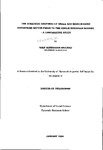THE STRATEGIC RESPONSE OF SMALL AND MEDIUM-SIZED ENTERPRISE SECTOR FIRMS TO THE SINGLE EUROPEAN MARKET - A COMPARATIVE STUDY
| dc.contributor.author | BRICKAU, RALF ALEXANDER | |
| dc.contributor.other | Plymouth Business School | en_US |
| dc.date.accessioned | 2013-09-18T11:18:26Z | |
| dc.date.available | 2013-09-18T11:18:26Z | |
| dc.date.issued | 1994 | |
| dc.identifier | NOT AVAILABLE | en_US |
| dc.identifier.uri | http://hdl.handle.net/10026.1/1842 | |
| dc.description.abstract |
The creation of the post-1992 European Single Market represents a significant change in the business environment confronting firms throughout Europe. Although there is an extensive source of literature available on appropriate strategic responses to the Single Market, very few of these writings contain guidance specifically related to the situation facing small and medium- sized enterprises (SMEs). The objectives of this study are i) to determine important veu-iables which might influence SME competitiveness, ii) how these may influence SME competitiveness and iii) to identiiy the formal or informal strategic approaches of SME firms responding to the challenge of the Single Market. To achieve these objectives a comparative study has been undertaken across approximately 200 UK and German SME food & drink processing firms. The first phase of the research involves a survey aimed at identifying which national, regional and company-specific variables may influence SME sector competitiveness in the Single European Market envirormient. British firms identify only a small number of crucially important vauriables whereas German respondents identify a much larger number of variables. Variables identified as having an important/very important influence on competitiveness are used in the second survey to determine whether these Eire likely to place firms in a stronger or weaker position on the competitive continuum within the post-1992 environment. UK firms are much more indifferent about competitive advantages and disadvantages compared to their German counterparts. German firms, in contrast, identify a balanced portfolio of disadvantages and advantages. The third survey is aimed at establishing companies' strategic approaches in terms of planning philosophy, market opportunities and internal capabilities. The survey establishes that German firms have a more formalised planning approach. Furthermore, most German SMEs follow a focused differentiation strategy, emphasising premium product performance with distinctive tangible and intangible benefits. At the same time increased emphasis is placed on making production more cost effective and efficient. Given that the identified strategic approach by the German firms appears to be the most appropriate strategic option for Northern European SME firms, it may be concluded that the latter appear to be in a stronger competitive position in the post-1992 environment. In contrast, small UK firms appear to reject the idea of getting actively involved in Single Market activities and continue to pursue domestic market issues. Findings indicate that UK respondents show distinctive gaps in their strategic approach. Hence, it can be anticipated that these firms are in a weaker position to counteract threats to their marketplaces from foreign competitors. A strategic response framework for SME firms is introduced and additional measures are discussed which may assist UK owner/managers to become more involved in formalised strategic plarming. This may lead to a more successful strategic response to the challenges of the Single European Market. | en_US |
| dc.language.iso | en | en_US |
| dc.publisher | University of Plymouth | en_US |
| dc.title | THE STRATEGIC RESPONSE OF SMALL AND MEDIUM-SIZED ENTERPRISE SECTOR FIRMS TO THE SINGLE EUROPEAN MARKET - A COMPARATIVE STUDY | en_US |
| dc.type | Thesis | |
| plymouth.version | Full version | en_US |
| dc.identifier.doi | http://dx.doi.org/10.24382/1621 | |
| dc.identifier.doi | http://dx.doi.org/10.24382/1621 |
Files in this item
This item appears in the following Collection(s)
-
01 Research Theses Main Collection
Research Theses Main


